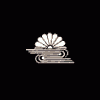I just have to emphasize Ford´s observations with a double-underline, and I take the liberty to add something for the context.
The clerical script (reisho) which was chosen by Natsuo was especially in fashion at that time (from the mid-19c into the Meiji period).
It was Ichikawa Bei´an (1779-1858) who gathered and systemized rubbings from Chinese monuments and bronze. He worked
for the Toyama fief as well as for the Maeda in Kaga (which is present-day Ishikawa, the neighboring prefecture of Toyama, and Toyama
is where my girlfriend works, so that´s maybe brutal off-topic but the explanation why I spent some time with this subject ).
So because of this "boom", we find also - frequently would be exaggregated but from time to time - Shinshinto blades with a reisho (or parts
in reisho) signature on the tang.
BTW: The meaning of the (nostalgic) poem is (maybe Koichi can correct me if wrong): "When I raise my head, I can see the moon from
beyond the mountains - and when I then bow down my head, I can recall my home village."





